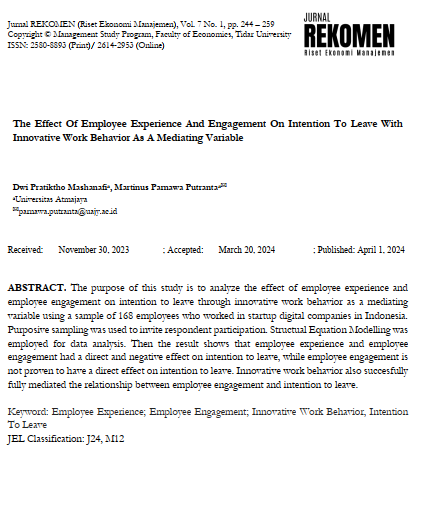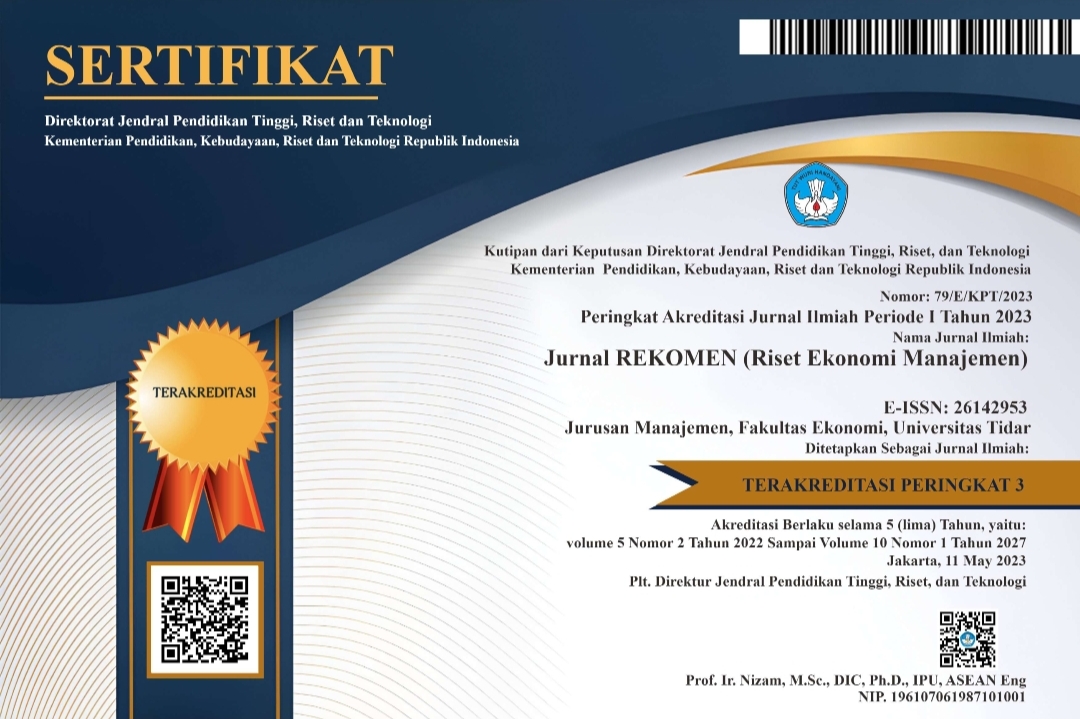The Effect of Employee Experience and Engagement on Intention to Leave with Innovative Work Behavior as a Mediating Variable
DOI:
https://doi.org/10.31002/rekomen.v7i1.1199Keywords:
Employee Experience, Employee Engagement, Innovative Work BehaviorAbstract
The purpose of this study is to analyze the effect of employee experience and employee engagement on intention to leave through innovative work behavior as a mediating variable using a sample of 168 employees who worked in startup digital companies in Indonesia. Purposive sampling was used to invite respondent participation. Structual Equation Modelling was employed for data analysis. Then the result shows that employee experience and employee engagement had a direct and negative effect on intention to leave, while employee engagement is not proven to have a direct effect on intention to leave. Innovative work behavior also succesfully fully mediated the relationship between employee engagement and intention to leave.
References
Ali, H., Li, M., & Qiu, X. (2022). Employee engagement and innovative work behavior among chinese millennials: mediating and moderating role of work-life balance and psychological empowerment. Frontiers in Psychology, 13, 1–15. https://doi.org/10.3389/fpsyg.2022.942580
Allen, D. G., Shore, L. M., & Griffeth, R. W. (2003). The Role of Perceived Organizational Support and Supportive Human Resource Practices in the Turnover Process. Journal of Management, 29(1), 99–118. https://doi.org/10.1177/014920630302900107
Alpha JWC Ventures, KEARNEY, & GRIT. (2023). ASEAN’s Growth & Scale Talent Playbook.
Azevedo, M. C. de, Schlosser, F., & McPhee, D. (2020). Building organizational innovation through HRM, employee voice and engagement. Personnel Review, 50(2), 751–769. https://doi.org/10.1108/PR-12-2019-0687
Basak, E., Ekmekci, E., Bayram, Y., & Bas, Y. (2013). Analysis of factors that affect the intention to leave of white-collar employees in Turkey using structural equation modelling. Proceedings of the World Congress on Engineering and Computer Science, 2, 1058–1062.
Bibb, A. (2023). How to scale your EX as a startup. Forbes. https://www.forbes.com/sites/forbesbusinesscouncil/2023/05/17/how-to-scale-your-ex-as-a-startup/?sh=674a77c7717b
Dery, K., Sebastian, I., & van der Meulen, N. (2017). The digital workplace is key to digital innovation. MIS Quaterly Executive, 16, 135–152.
El-Hanafy, T. M. M. M. (2020). The impact of innovative work behavior on employees’ intention to leave: the meditation role of employees’ readiness to marketing innovation at the private higher education institutions in Egypt (Pheis). International Journal of Scientific & Engineering Research, 11(6), 1666–1678. https://doi.org/10.14299/ijser.2020.06.05
Erwina, P. (2022). The analysis of employee experience, employee engagement, and turnover intention at XYZ aesthetic clinic. International Journal of Management, Entrepreneurship, Social Science and Humanities, 5(1), 242–252. http://journals.researchsynergypress.com/index.php/ijmesh
Hamid, R. S., & Anwar, S. M. (2019). Structural Equation Model (SEM) Berbasis Varian: Konsep Dasar dan Aplikasi dengan Program SmartPLS 3.2.8 dalam Riset Bisnis.
Janssen, O. (2000). Job Demands, Perceptions of Effort-Reward Fairness nd Innovative Work Behavior. Journal of Occupational and Organizational Psychology, 73, 287–302.
Jong, J. De, & Hartog, D. Den. (2010). Measuring Innovative Work Behavior. Creativity and Innovation Management, 19(1), 23–36. https://doi.org/10.1111/j.1467-8691.2010.00547.x
Kaymakcı, R., Görener, A., & Toker, K. (2022). The perceived overqualification’s effect on innovative work behaviour: Do transformational leadership and turnover intention matter? Current Research in Behavioral Sciences. https://doi.org/10.1016/j.crbeha.2022.100068
Lobell, K. O. (2020). 5 ways to stop a valiued employee efrom quitting. SHRM. https://www.shrm.org/resourcesandtools/hr-topics/employee-relations/pages/5-ways-to-stop-a-valued-employee-from-quitting.aspx
Maslach, C., Schaufeli, W. B., & Leiter, M. P. (2001). Job burnout. Annual Review of Psychology, 52, 397–422. https://doi.org/10.1146/annurev.psych.52.1.397
Masyarakat Industri Kreatif Teknologi Informasi dan Komunikasi Indonesia. (2021). Mapping & Database Startup Indonesia. Masyarakat Industri Kreatif Teknologi Informasi dan Komunikasi Indonesia.
Mobley, W. H., Griffeth, R. W., Hand, H. H., & Meglino, B. M. (1979). Review and conceptual analysis of the employee turnover process. Psychological Bulletin, 86(3), 493–522. https://doi.org/10.1037/0033-2909.86.3.493
Panneerselvam, S., & Balaraman, K. (2022). Employee experience: The new employee value proposition. Strategic HR Review, 21(6), 201–207. https://doi.org/10.1108/shr-08-2022-0047
Pine, B. J., & Gilmore, J. H. (1998). Welcome to the experience economy. Harvard Business Review, 76, 97–105.
Plaskoff, J. (2017). Employee experience: the new human resource management approach. Strategic HR Review, 16(3), 136–141. https://doi.org/10.1108/shr-12-2016-0108
Price, J. L. (1989). The impact of turnover on the organization. Work and Occupations, 16(4), 461–473.
Pukkeeree, P., Na-Nan, K., & Wongsuwan, N. (2020). Effect of Attainment Value and Positive Thinking as Moderators of Employee Engagement and Innovative Work Behaviour. Journal of Open Innovation: Technology, Market, and Complexity, 6(69), 1–15. https://doi.org/10.3390/joitmc6030069
Rich, B. L., LePine, J. A., & Crawford, E. R. (2010). Job engagement: Antecedents and effect on job performance. Academy of Management Journal, 53, 617–635. https://doi.org/doi:10.5465/AMJ.2010. 51468988
Saks, A. M. (2006). Antecedents and consequences of employee engagement. Journal of Managerial Psychology, 21. doi:10.1108/026839406 10690169
Schaufeli, W. B., Bakker, A. B., & Salanova, M. (2006). The Measurement of Work Engagement With a Short Questionnaire. Educational and Psychological Measurement, 66(4), 701–716. https://doi.org/10.1177/0013164405282471
Schaufeli, W. B., Salanova, M., Gonzales-Roma, V., & Bakker, A. B. (2002). THe measurement of engagemet and burnout: A two sample confirmatory factor analytic approach. Journal of Happiness Studies, 3, 71–92. https://doi.org/doi:10.1023/A:10156 30930326
Shuck, B., Adelson, J. L., & Reio, T. G. (2016). The employee engagement scale: initial evidence for construct validity and implications for theory and practice. Human Resource Mangement, 56(6), 953–977. https://doi.org/10.1002/hrm
Shuck, B., Twyword, D., Reio, T. G., & Shuck, A. (2014). Human resource develoment practice and employee engagement: Examining the connection with employee turnover intentions. Human Resource Development Quarterly, 25(2), 239–270. https://doi.org/10.1002/hrdq
Soanne, E., Truss, C., Shantz, A., Rees, C., & Gatenby, M. (2012). Development and application of a new measure of employee engagement: The ISA engagement scale. Human Resource Development International, 15, 529–547. https://doi.org/10.1080/13678868.2012.726542
Srivastava, S., & Bajpai, L. (2021). Linking conservation of resource perspective to personal growth initiative and intention to leave: role of mediating variables. Personnel Review, 50(2), 686–708. https://doi.org/10.1108/PR-10-2019-0548
Startup Ranking. (2023). Startup Ranking Based on Countries. Startup Ranking. https://www.startupranking.com/countries
Tucker, E. (2020). Driving engagement with the employee experience. Strategic HR Review, 19(4), 183–187. https://doi.org/10.1108/shr-03-2020-0023
West, M. A. (1989). Innovation Amongst Health Care Professionals. Social Behavior, 4, 173–184.
West, M. A., & Farr, J. L. (1989). Innovation at Work: Psychological Perspectives. Social Behavior, 4, 15–30.
Yadav, M., & Vihari, N. S. (2021). Employee Experience: Construct Clarification, Conceptualization and Validation of a New Scale. FIIB Business Review, 1–15. https://doi.org/10.1177/23197145211012501
Zhao, X., Lynch, J. G., & Chen, Q. (2010). Reconsidering Baron and Kenny : Myths and Truths about Mediation Analysis. Journal of Consumer Research, 37(2), 197–206. https://doi.org/10.1086/651257

Downloads
Published
Versions
- 2024-04-02 (2)
- 2024-04-01 (1)
Issue
Section
License
Copyright (c) 2024 Jurnal REKOMEN (Riset Ekonomi Manajemen)

This work is licensed under a Creative Commons Attribution-ShareAlike 4.0 International License.


















